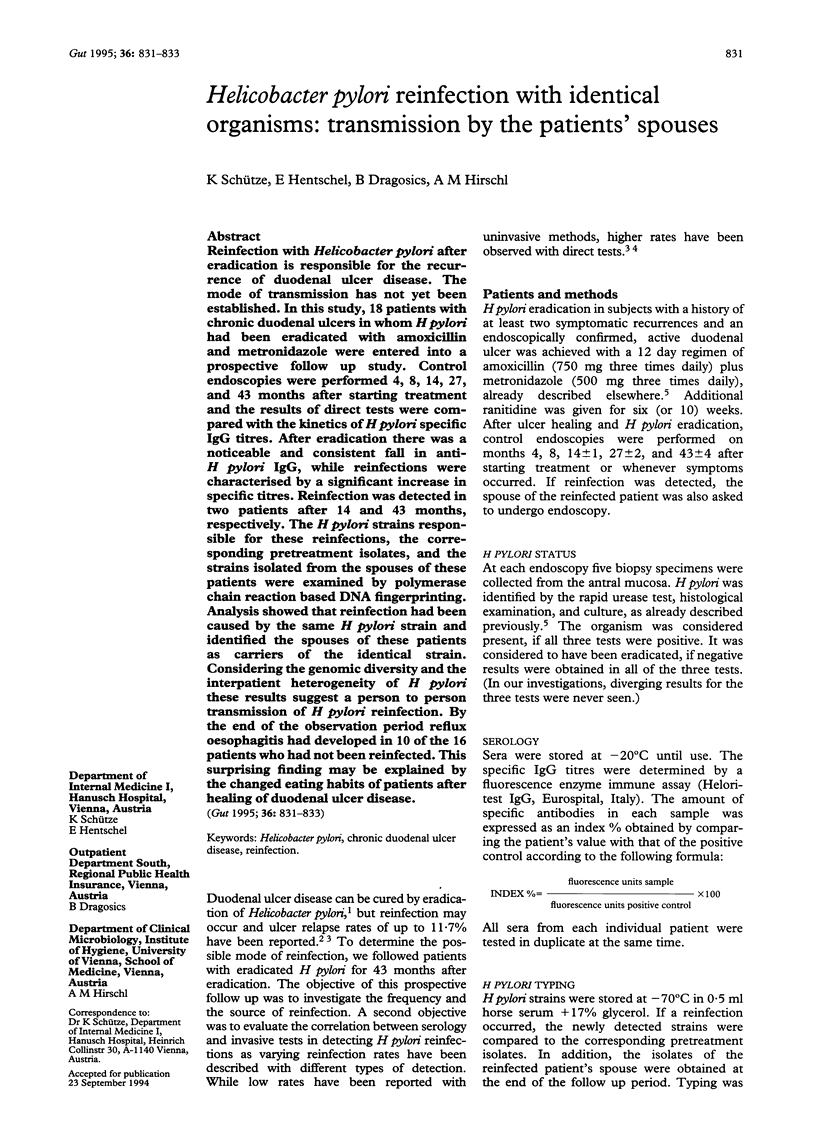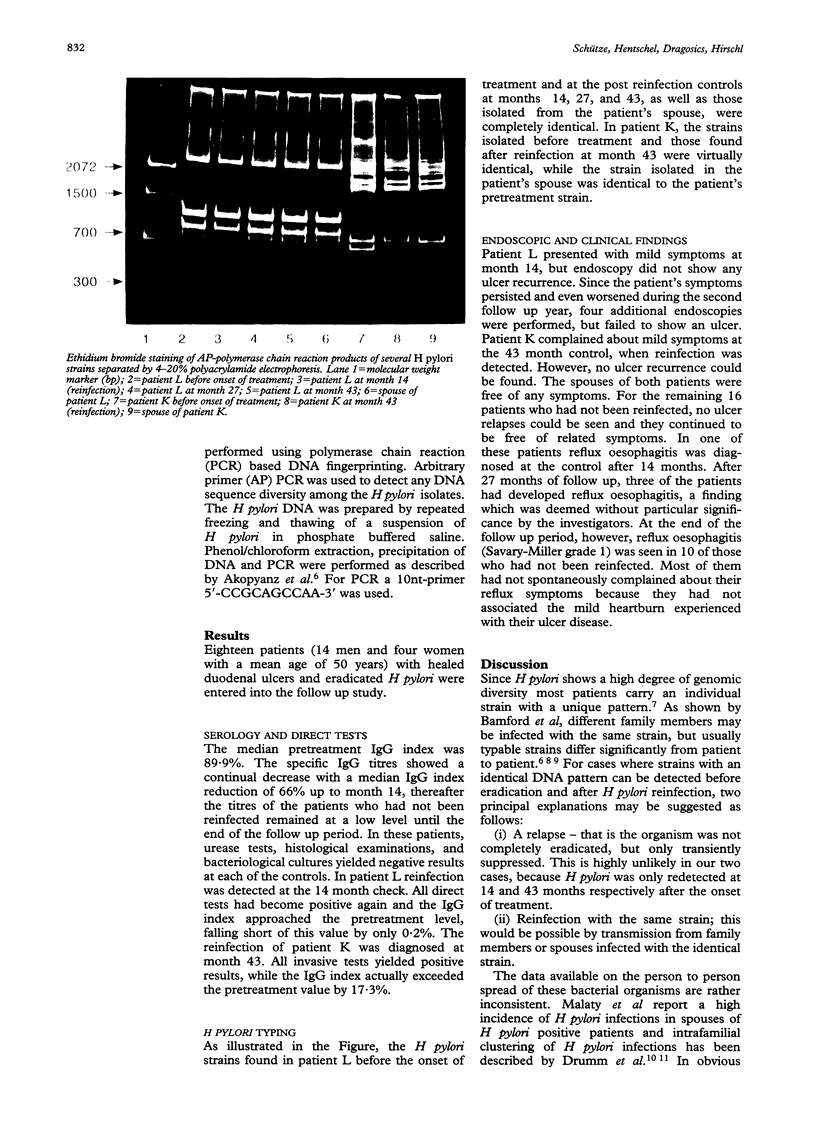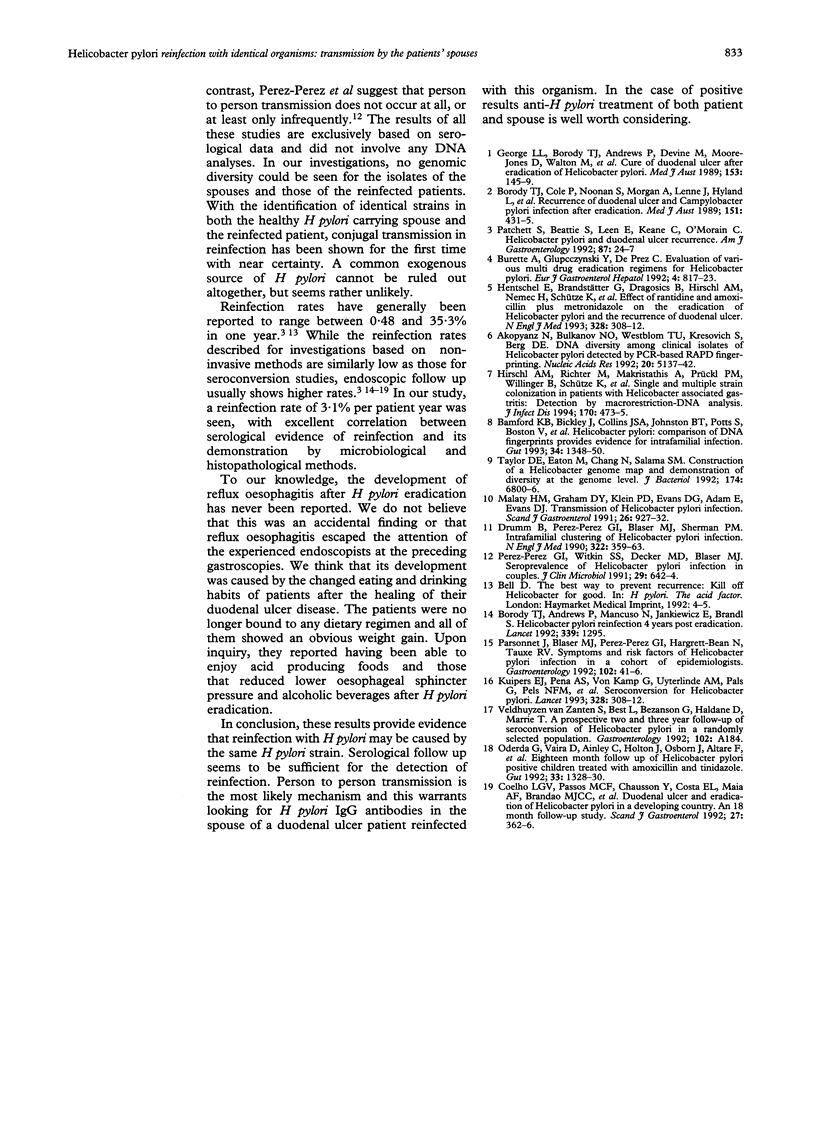Abstract
Reinfection with Helicobacter pylori after eradication is responsible for the recurrence of duodenal ulcer disease. The mode of transmission has not yet been established. In this study, 18 patients with chronic duodenal ulcers in whom H pylori had been eradicated with amoxicillin and metronidazole were entered into a prospective follow up study. Control endoscopies were performed 4, 8, 14, 27, and 43 months after starting treatment and the results of direct tests were compared with the kinetics of H pylori specific IgG titres. After eradication there was a noticeable and consistent fall in anti-H pylori IgG, while reinfections were characterised by a significant increase in specific titres. Reinfection was detected in two patients after 14 and 43 months, respectively. The H pylori strains responsible for these reinfections, the corresponding pretreatment isolates, and the strains isolated from the spouses of these patients were examined by polymerase chain reaction based DNA fingerprinting. Analysis showed that reinfection had been caused by the same H pylori strain and identified the spouses of these patients as carriers of the identical strain. Considering the genomic diversity and the interpatient heterogeneity of H pylori these results suggest a person to person transmission of H pylori reinfection. By the end of the observation period reflux oesophagitis had developed in 10 of the 16 patients who had not been reinfected. This surprising finding may be explained by the changed eating habits of patients after healing of duodenal ulcer disease.
Full text
PDF


Images in this article
Selected References
These references are in PubMed. This may not be the complete list of references from this article.
- Akopyanz N., Bukanov N. O., Westblom T. U., Kresovich S., Berg D. E. DNA diversity among clinical isolates of Helicobacter pylori detected by PCR-based RAPD fingerprinting. Nucleic Acids Res. 1992 Oct 11;20(19):5137–5142. doi: 10.1093/nar/20.19.5137. [DOI] [PMC free article] [PubMed] [Google Scholar]
- Bamford K. B., Bickley J., Collins J. S., Johnston B. T., Potts S., Boston V., Owen R. J., Sloan J. M. Helicobacter pylori: comparison of DNA fingerprints provides evidence for intrafamilial infection. Gut. 1993 Oct;34(10):1348–1350. doi: 10.1136/gut.34.10.1348. [DOI] [PMC free article] [PubMed] [Google Scholar]
- Borody T. J., Cole P., Noonan S., Morgan A., Lenne J., Hyland L., Brandl S., Borody E. G., George L. L. Recurrence of duodenal ulcer and Campylobacter pylori infection after eradication. Med J Aust. 1989 Oct 16;151(8):431–435. doi: 10.5694/j.1326-5377.1989.tb101251.x. [DOI] [PubMed] [Google Scholar]
- Borody T., Andrews P., Mancuso N., Jankiewicz E., Brandl S. Helicobacter pylori reinfection 4 years post-eradication. Lancet. 1992 May 23;339(8804):1295–1295. doi: 10.1016/0140-6736(92)91622-f. [DOI] [PubMed] [Google Scholar]
- Coelho L. G., Passos M. C., Chausson Y., Costa E. L., Maia A. F., Brandao M. J., Rodrigues D. C., Castro L. P. Duodenal ulcer and eradication of Helicobacter pylori in a developing country. An 18-month follow-up study. Scand J Gastroenterol. 1992 May;27(5):362–366. doi: 10.3109/00365529209000088. [DOI] [PubMed] [Google Scholar]
- Drumm B., Perez-Perez G. I., Blaser M. J., Sherman P. M. Intrafamilial clustering of Helicobacter pylori infection. N Engl J Med. 1990 Feb 8;322(6):359–363. doi: 10.1056/NEJM199002083220603. [DOI] [PubMed] [Google Scholar]
- Hentschel E., Brandstätter G., Dragosics B., Hirschl A. M., Nemec H., Schütze K., Taufer M., Wurzer H. Effect of ranitidine and amoxicillin plus metronidazole on the eradication of Helicobacter pylori and the recurrence of duodenal ulcer. N Engl J Med. 1993 Feb 4;328(5):308–312. doi: 10.1056/NEJM199302043280503. [DOI] [PubMed] [Google Scholar]
- Hirschl A. M., Richter M., Makristathis A., Prückl P. M., Willinger B., Schütze K., Rotter M. L. Single and multiple strain colonization in patients with Helicobacter pylori-associated gastritis: detection by macrorestriction DNA analysis. J Infect Dis. 1994 Aug;170(2):473–475. doi: 10.1093/infdis/170.2.473. [DOI] [PubMed] [Google Scholar]
- Oderda G., Vaira D., Ainley C., Holton J., Osborn J., Altare F., Ansaldi N. Eighteen month follow up of Helicobacter pylori positive children treated with amoxycillin and tinidazole. Gut. 1992 Oct;33(10):1328–1330. doi: 10.1136/gut.33.10.1328. [DOI] [PMC free article] [PubMed] [Google Scholar]
- Parsonnet J., Blaser M. J., Perez-Perez G. I., Hargrett-Bean N., Tauxe R. V. Symptoms and risk factors of Helicobacter pylori infection in a cohort of epidemiologists. Gastroenterology. 1992 Jan;102(1):41–46. doi: 10.1016/0016-5085(92)91782-y. [DOI] [PubMed] [Google Scholar]
- Perez-Perez G. I., Witkin S. S., Decker M. D., Blaser M. J. Seroprevalence of helicobacter pylori infection in couples. J Clin Microbiol. 1991 Mar;29(3):642–644. doi: 10.1128/jcm.29.3.642-644.1991. [DOI] [PMC free article] [PubMed] [Google Scholar]
- Taylor D. E., Eaton M., Chang N., Salama S. M. Construction of a Helicobacter pylori genome map and demonstration of diversity at the genome level. J Bacteriol. 1992 Nov;174(21):6800–6806. doi: 10.1128/jb.174.21.6800-6806.1992. [DOI] [PMC free article] [PubMed] [Google Scholar]



